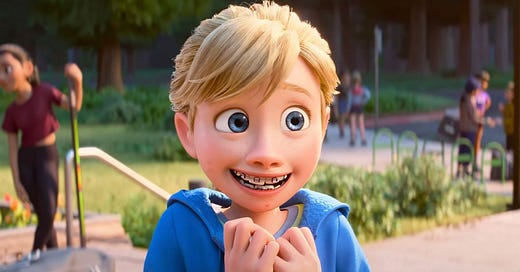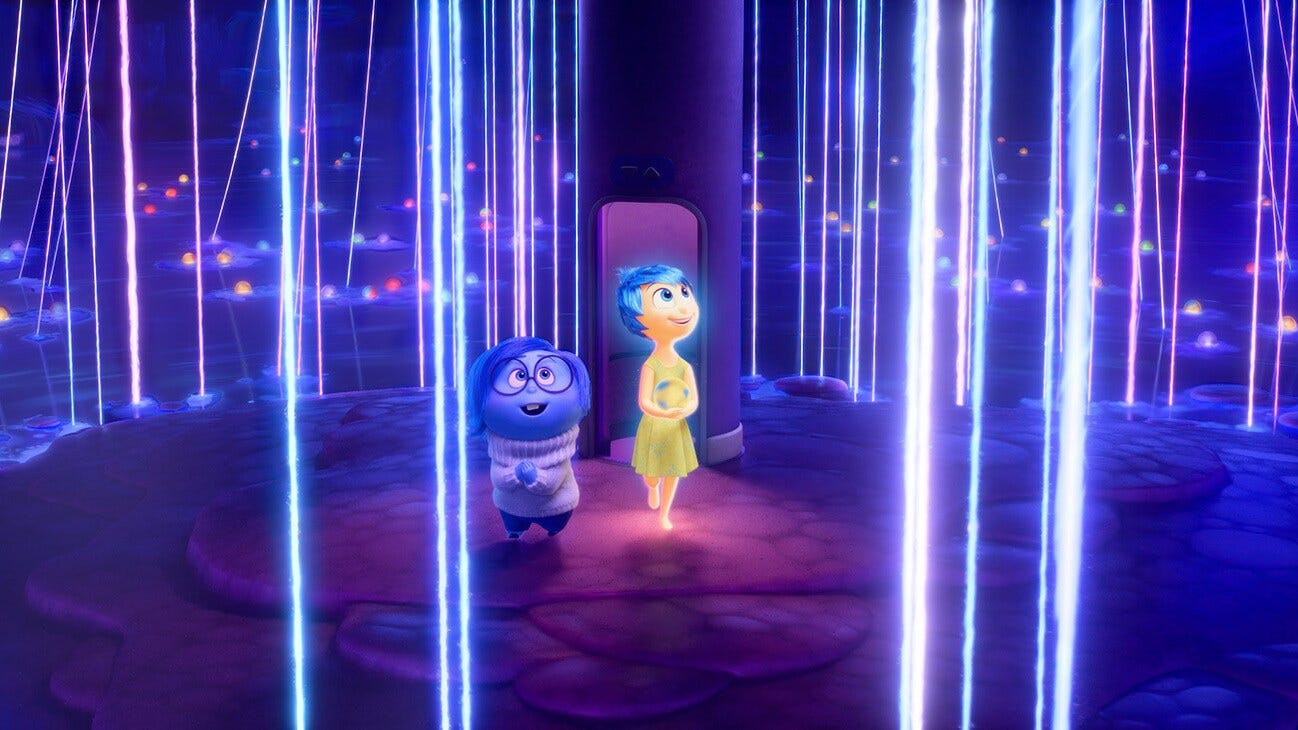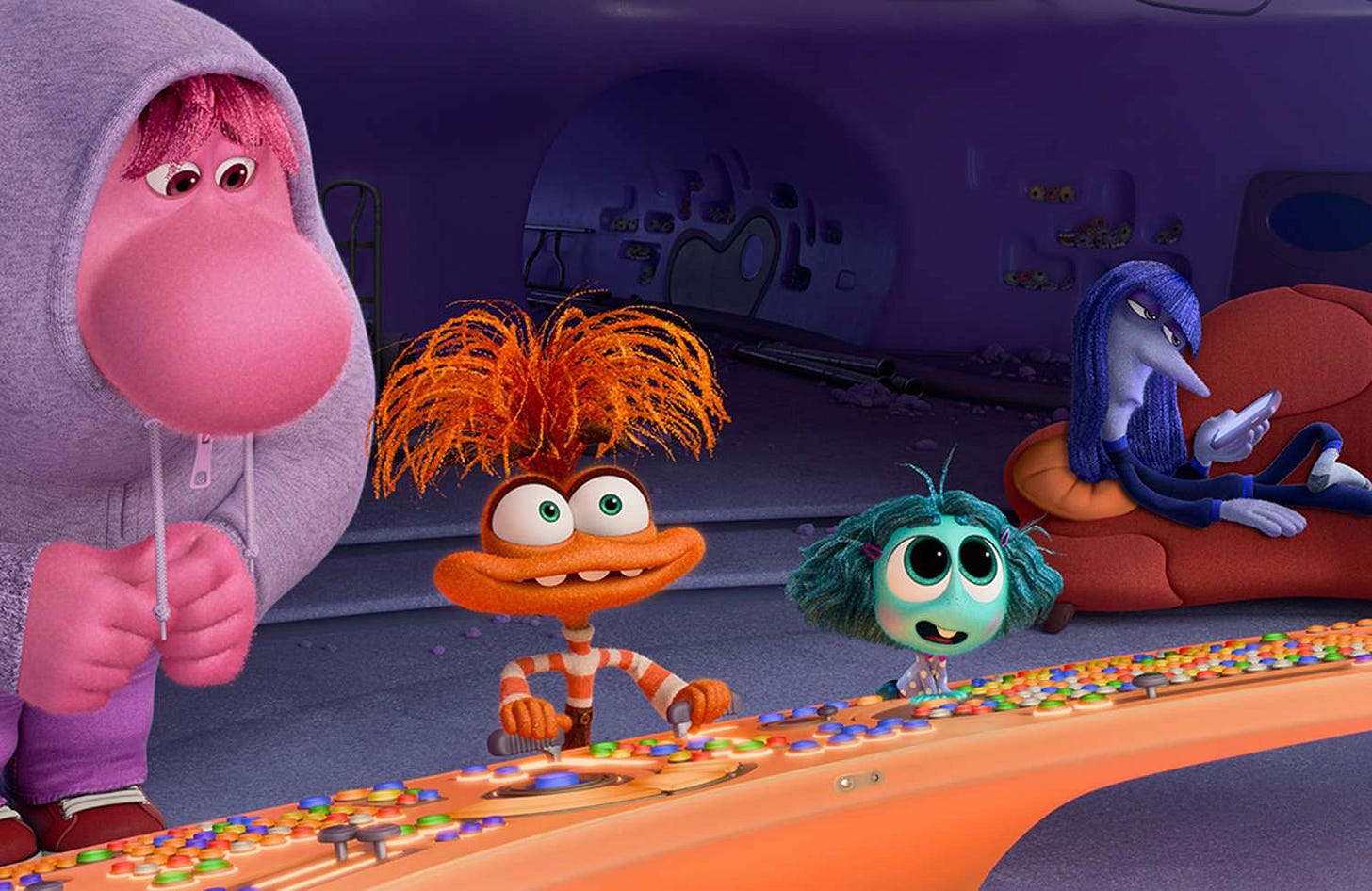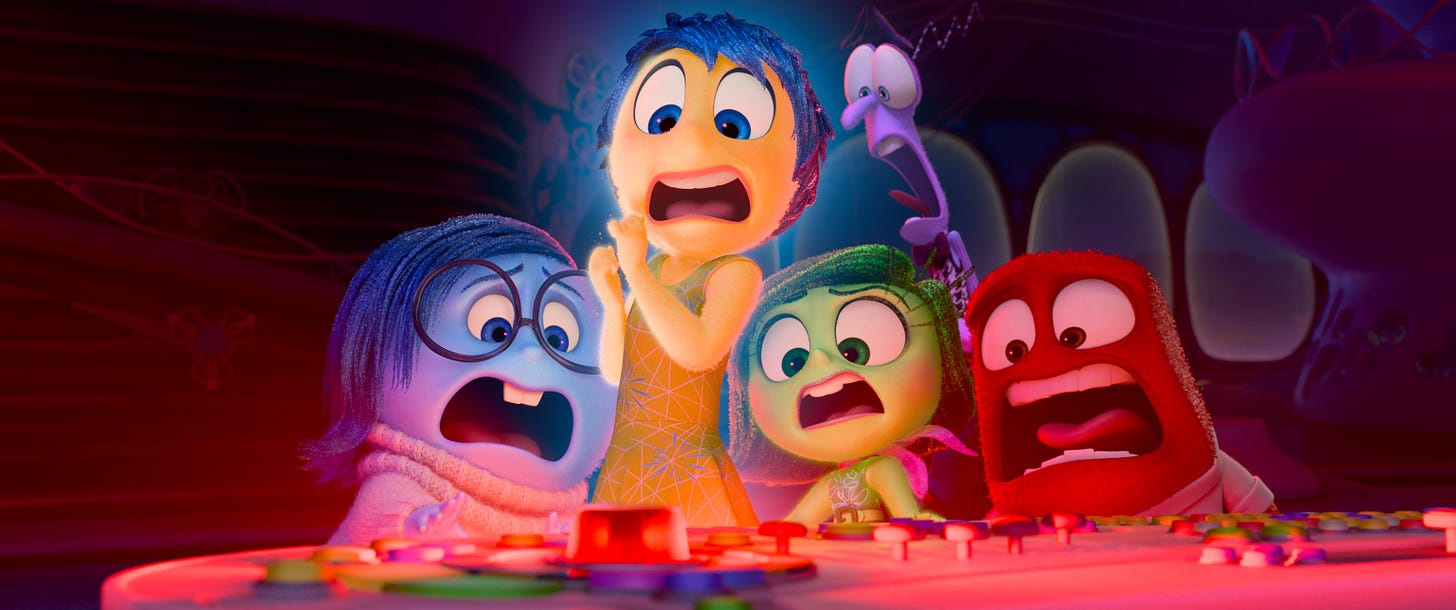Inside Out 2 disappoints creatively
The saccharine sequel doubles down on what made the original (not) work
After more than a decade of revolutionizing and then subsequently dominating the American animation industry, culminating with two Best Picture nominations in a row, Pixar Animation Studios suffered a creative drought and, most importantly to their new corporate overlords, a commercial stagnation; I’m an outspoken supporter of Monsters University, but the studio’s output in the early 2010s failed to ignite the same cultural fixation that earlier entries in Pixar’s filmography had. It felt as if the studio, which made three sequels in the span of three years, was losing its creative spark that defined its image for so long. But then Inside Out came along; many reviews at the same time heralded Pete Docter’s 2015 film (which, while a bit derivative, was, importantly, an original IP) as a return to form for Pixar, a back-to-basics narrative that leaned on what were perceived as Pixar’s core strengths. It also didn’t hurt that the film made almost a billion dollars at the box office, giving Disney and Pixar a much-needed confidence boost. For the rest of the decade, Pixar never quite returned to its golden age success, but Inside Out proved to be a guiding star that informed the studio’s trajectory going forward. But as the pandemic kept audiences at home, Disney made the controversial decision to launch Soul, Luca, and Turning Red on Disney+, training audiences to expect theatrical quality day-and-date from the comfort of their couches. When Disney finally returned Pixar to a theatrical model, the verdict was in - audiences didn’t want to return to theaters to see these films. The Toy Story spinoff Lightyear was a massive disappointment, and 2023’s Elemental, despite proving to be a sustainable box office player, failed to satisfy the bean counters. In a Hail Mary pass, Inside Out 2 serves a similar function as its predecessor - to return Pixar to its former glory, to remind audiences of the studio’s talent, and, above all, to make a shit ton of money. But as a film, this sequel, directed by Kelsey Mann, doubles down on everything about the first film, for better or for worse - and in the opinion of this reviewer, it is for the worse.
While I enjoyed the film when I first saw it, Inside Out quickly became one of those films that just…bugged me. There’s nothing more annoying than hearing overwhelming and near-universal praise heaped on a film that is, from my perspective, only fine and is deeply flawed on several levels. Even when I revisit the film every few years, I find myself increasingly frustrated at the missed potential and others’ seemingly ignorant adoration. Despite all advertising suggesting the contrary, I was cautiously optimistic that the sequel would at least try to improve on the original’s shortcomings. This, of course, was foolish of me - why would Pixar try to fix something they see as fundamentally “ain’t broke”? As a result, Inside Out 2 suffers from all of the same issues as the original, but with a few new ones thrown in just for good measure. At least the 2015 film was an original idea that had competent, if banal, thematic ambitions, but its sequel feels like a lazy retread of its predecessor. The character Joy is ejected from headquarters, she must make her way back, and she must learn to accommodate the emotion that’s causing the film’s conflict. It’s like Joy has regressed as a character - sure, she’s much more inclusive of the other four, especially Sadness, but when new emotions enter the equation, she once again tries to put a box around their agency, rightfully so or not. Haven’t we done this before? Hasn’t she already learned this lesson? To top it all off, the film struggles with the same issue that Pixar’s sequels have had since Cars 2 - they don’t feel like the next equally important installment in these characters’ stories, but rather an additional adventure, a postscript that lacks the emotional or thematic weight of the original. To this end, aside from the importance that Disney and Pixar have placed on it, Inside Out 2 feels wholly unnecessary.
Like its predecessor, the film is painfully twee - the only thing separating it from an after school special is production value and cultural cache. All of the ideas explored in these two films are, in a real world sense, immensely important and perfectly reasonable - I’m not trying to minimize mental health struggles in any way, shape, or form. But to call these explorations “ideas” gives them far too much credit. They’re really more like “lessons” leading to superficial platitudes like “You need to accommodate sadness in your life” for the first film and “Anxiety can’t control your life” for this film. In a more sophisticated narrative, a central thematic idea could be “Anxiety leads people to make short-sighted and self-centered decisions that damage their interpersonal relationships.” Sure, this idea is there, but it’s buried underneath a “message” that’s given a misguided priority. Just because a film explores something that really does affect people doesn’t automatically make a film narratively affecting. Stories should intellectually stimulate and emotionally arouse, revealing something about the human condition, yet this film reminds us of something we should remember as opposed to something we should know…if that makes sense…
I also find the central premise of both films extremely limiting in achieving such ends. Many people have accused me of disliking these films because, ultimately, it wasn’t made for me; these films speak to women, whose childhood and adolescence is particularly emotionally turbulent. In this sense, the films provide much needed representation and validation for these struggles. But I reject the basis of this argument on several levels: 1) this implies our engagement in a story is directly proportional to our similarities to its protagonist, 2) films can’t and shouldn’t try to speak to something essential and basic to the human experience, and 3) these films as constructed are a less-than-optimal way to explore this reality. Focusing on the latter point, I want more stories that explore a young girl going through emotional (and, in this film, physical) changes…so why couldn’t this film just be about a young girl going through emotional and physical changes? Why must there always be some cartoonish angle? To say an animated film should justify its existence as an animated film by leaning into cartoonish character designs and wacky colorful antics undervalues the medium. Rather, an animated film justifies its existence by using the medium and its formal characteristics to elevate its narrative. But it’s obvious that the central conceit is to anthropomorphize human emotions. Think of it this way - if they were to make an Inside Out 3 (which now feels inevitable), but they were to either cut out the emotions storyline or the real world storyline, which could they cut and have the film still feel like an Inside Out sequel? Obviously, you could cut Riley out altogether and focus on the new emotions of a new person - but a story focused squarely on Riley seems, from a corporate viewpoint, impractical and, frankly, impossible.
By constructing the narrative and premise in this way, Riley feels secondary to her own story, conflicting with the proposed value of these films being an exploration of a young girl’s journey. Extended sequences of Riley just living her life are easily the highlights of this film, where we get to see her interact with her current friends and try to make new ones - and how those two actions conflict with one another. Film is a visual medium, and characters should reveal who they are through their actions. But if you have the convenient narrative device of just having someone’s interior thoughts made visually manifest, then you have very little need to give a character like Riley strong active choices. It is the emotions that get to make decisions that impact the narrative, making Riley a passive character when laying out the external story’s structural beats. She’s controlled like a robot, switchboard and all, though it’s implied that Riley can exert some agency, against the wishes of her emotions. This raises all of the same logical questions from the first film. How much do the emotions control her? Do the emotions themselves have emotions? The original film seemed to suggest that more adult, complex emotions were just the cooperation of the five basic emotions, and anxiety seemed like it would be a mixture of Fear and Sadness. But now we literally have Anxiety as a character, so the internal logic of this world continues to fall apart upon even the most basic scrutiny. Plot holes rarely matter, if at all, but when they impact our emotional and thematic understanding of the story and these characters, they can become major problems.
“The reviewer does not like Inside Out 2.” This is what ChatGPT told me when I gave it this review and asked “based on this review, does this person like Inside Out 2?” But my stance on this film is the same as the first - it’s fine. There are certainly moments of quality, even excellence - the animation, especially in the real-world, is gorgeous, and there are some truly laugh-out-loud moments that were both unexpected and refreshing. But if everyone hails Kelsey Mann’s directorial debut as a cinematic triumph, I feel compelled, almost compulsively so, to set the record straight. But the box office has rewarded Disney and Pixar, making this film not only their most successful film in quite some time, but one of the most successful films of the year, single handedly saving the summer movie season. The studio has indicated that they will be leaning more heavily on their established brands and less on new, more personal projects, but this film was the test case. Hollywood always, without fail, takes the wrong lessons from success and failure, and I’m sure the Monday after this film’s mammothly successful opening weekend inspired a hastily assembled executive meeting to greenlight sequels and reboots of Toy Story, The Incredibles, Finding Nemo, Monsters, Inc., and other popular Pixar franchises. But the bean counters seem to forget that all of these established brands were once themselves original ideas. Like generative AI models, these systems need original input, lest the output becomes increasingly self-referential and diluted. If Pixar relies exclusively on its existing intellectual property, the well will eventually run dry. My very first review for this newsletter was for 2022’s Turning Red, and I wrote that “Turning Red is a fantastic example of what happens when filmmakers from underrepresented groups get their chance to share their stories. The result [...] is a textured experience saturated with character, style, and heart [...].” I doubt we’ll be getting more films like it anytime soon.










Fascinating.
*This* is the movie you want to go after for having a superficial, hollow message? The family film thoughtful enough to express that a mantra of “I’m a good person” can actually put impossible standards on children? A film that conveys this idea so brilliantly and accessibly? This is what we’re going after for creative bankruptcy? Even your suggestion of how the film could have explored the concept of anxiety is an oversimplification of what is actually present in the story.
In general, the review seems to misrespresent the film that was delivered. Joy doesn’t try to box out the other emotions; she concedes their importance. Throughout the film, her goal is simply to come to a resolution, and it is always a resolution intended to be inclusive of the new emotions.
If audiences around the world in record numbers recognize the film as a cinematic triumph, then it simply is. There is no “record to set straight.” You write this review as if only you know the truth, and that anyone who connects with the film is wrong to do so. Simply put, the film does not resonate with you, and that seems to be since you disagree inherently with the execution of the premise of the entire series. But a reviewer should judge a film for what it is, not for what they would have made instead.
These are simply my two cents. Above all, I mainly just feel bad that you couldn’t get into either of the Inside Out films. And since you keep revisiting the original every few years, it appears so do you. Hopefully at some point down the line you can appreciate them for what they are, as opposed to whatever you want them to be.